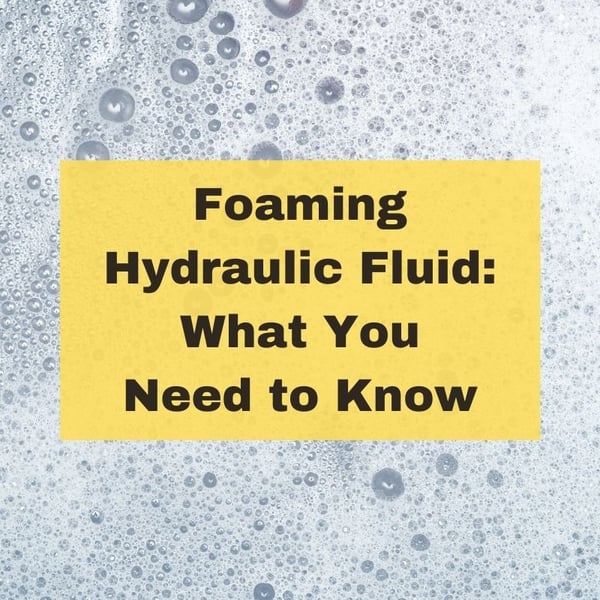Foaming hydraulic fluid isn't a big deal, right? Well, you might want to think again. If left unaddressed, it can lead to problems that can even affect your final drive motor. Here are the basics on foaming and what you can do about it.

This is the second of a multi-part series about air contamination of hydraulic fluid.
Here is Part 1: Types of Air Contamination in Hydraulics
Here are a few other Shop Talk Blog posts you might find helpful:
Here's the official definition of foam in hydraulic fluid: clusters of air bubbles with a diameter greater than 1 mm in diameter (about the thickness of a credit card or ID card) on the surface of your hydraulic fluid. It usually forms when hydraulic fluid is mixed with air from a free surface. As the air becomes trapped in the fluid it forms bubbles of air. As those bubbles begin to rise to the surface of the hydraulic fluid they group together to form foam.
Issues Caused by Foaming Hydraulic Fluid
While not as serious as entrained air, foaming can lead to ...
- Reservoir overflows
- Compromised lubrication abilities
- Oxidation leading to premature aging of the hydraulic fluid
- Entrained air
And if foaming does lead to entrained air in your hydraulic fluid, then cavitation and pitting damage can result. And of these issues, lubrication problems and cavitation problems are the most serious when it comes to your final drive.
How Bubbles Form in Hydraulic Fluid
Air entrainment — how it happens from Hydraulics & Pneumatics explains how air entrapment occurs:
- Release of dissolved air as pressure drops (e.g., orifices, valves, and where the hydraulic fluid returns to the reservoir)
- Improper bleeding of the hydraulic system
- Leaks that cause a vacuum (i.e., suction line)
- Contamination by surface-active compounds
- Contamination that causes air release agents or antifoam to precipitate and be unable to do their job
- Splashing fluid as it is added to the system
- Poorly designed hydraulic reservoirs
Now let's talk about where these bubbles are most likely to form. Anywhere there's a drop in system pressure can be a problem. For example, throttles and orifices can have pressure drops large enough for bubbles to form, as well as valves that open and close very quickly. This can be especially problematic at the end of a pipe when a valve is suddenly opened. Pipe joints and branches can also lead to the formation of bubbles. And don't forget that when a pump suddenly stops it can cause shockwaves that can cause bubbles to form.
What Causes Foaming Hydraulic Oil
According to Causes and Solutions for Foaming in Oil, there are several possibilities as to why your hydraulic fluid is foaming. They include:
- Contamination in the form of either water, solids, or even grease
- Cross-contamination with the wrong type of fluid
- Excessive aeration of the hydraulic fluid (which is usually a mechanical issue)
- A reduction in pump output efficiency
If you've already been using defoamant, foam can still form if you are using too much or if it has depleted
How Hydraulic Engineers Design Systems to Prevent Foaming
When designing a hydraulic system, engineers will include certain measures to minimize the formation of foam. For example, baffles are included in the reservoir to prevent fluid from the return line heading directly to the pump. You'll also see breather filter caps around the reservoir. These are very important because they help maintain atmospheric pressure in the reservoir as fluid is pumped in and out.
Fixing Foaming Hydraulic Fluid
One way to deal with the presence of foam is to add an anti-foaming agent to the hydraulic fluid. Anti-foaming agents will usually contain ester or silicone oil. They spread over the surface of the fluid and the foams. Over time, they are able to "pop" the bubbles and release the trapped air. Here's a great video explaining how they work.
Conclusion
While foam isn't as serious as some other forms of air contamination, it can still lead to problems that can impact your final drive motor. Accelerated aging of your hydraulic fluid, spongy operation, and even cavitation erosion can result from unaddressed hydraulic foaming. Your best bet is to check with your manufacturer to find out what kind of defoaming or anti-foaming agent they recommend.


